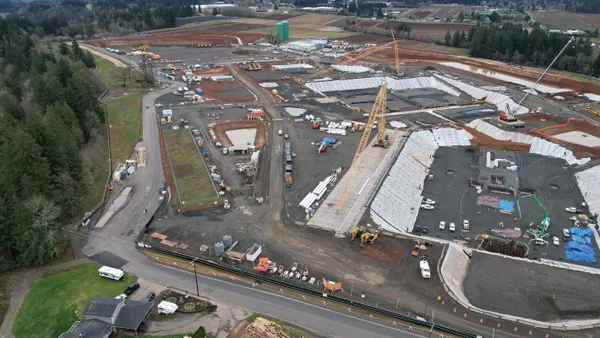Diversity programs, an equity index and increased recruitment efforts are among the tools that transportation agencies and other groups are using to improve diversity in the infrastructure workforce, according to comments from participants on a webinar panel in July hosted by United For Infrastructure, a Washington, D.C.-based nonpartisan organization that advocates for the renewal of the country's roads, bridges and more.
These agencies and groups say it’s imperative to attract employees from all backgrounds in order to help alleviate the current labor crunch. June construction employment in 39 states remained below the pre-pandemic peak of February 2020, according to an analysis of federal government data by the Associated General Contractors of America.
For instance, the California State Transportation Agency is developing an equity index, according to David Kim, secretary of the agency that manages the state’s roads, trains and water transportation systems. The tool will help evaluate projects and investments through an equity lens.
This could "very well be the first analytical tool of its type anywhere in the country," Kim said during the panel.
CalSTA additionally will add diversity and inclusion statements on job advertisements and will compare their employee demographics at the district and divisional level with those of the regions that it serves, according to Kim.
"It's our job as leaders to eliminate barriers and create a workforce that truly represents the communities we serve," said Kim. "We are taking steps right now to improve our recruitment, hiring and contracting practices, as well as leadership development opportunities for all employees to make sure they've got the skills and the tools to grow as leaders."
Diversity programs in the works
The California High-Speed Rail Authority is also partnering with schools to provide internships, fellowships and entry-level job opportunities on the high speed rail project that will run from Merced to Bakersfield. The initiative places a "really strong emphasis on expanding opportunities for women and others who have historically been underrepresented when it comes to jobs in the transportation sector," said Kim.
For this reason, organizations across the country strive to create career paths for people traditionally underrepresented in the industry. Among them is Oregon Tradeswomen, a Portland, Oregon-based nonprofit, that specializes in helping women prepare for careers in the skilled construction trades.
"There’s a lot of research that demonstrates diverse teams in the construction sector have higher levels of productivity, higher levels of retention, higher levels of loyalty and problem solving and that's a value add for business," said Kelly Kupcak, the group's executive director. "There is some momentum around the conversation of equity that in large part, was lifted up by the Black Lives Matter movement. We’ve seen a new awareness around what equity means from a racial perspective, certainly, but also a gender equity perspective."
Unlike a four-year degree, its program lasts eight weeks for a total of 192 hours, allowing students to quickly join the construction workforce. She said the average starting wage last year for women who went through the program was $22.81.
Kupcak pointed to the National Taskforce on Tradeswomen’s Issues' 10 points on infrastructure equity, and "very tangible things that Congress can do to support equity and infrastructure." The National Taskforce on Tradeswomen's Issues mission is to unite local, regional and national expertise and action to support tradeswomen and women in achieving access, opportunity and equity in the construction industry, according to its website.
For example, among the 10 points are annually updated numeric participation goals for the percentage of total hours worked by women and minorities and public online reporting of achievements toward participation goals. The nonprofit encourages any infrastructure package passed to include these components.
Solving the public image problem
A major issue in the construction industry is a skilled workforce shortage, said Brian Turmail, vice president of public affairs and strategic initiatives at Associated General Contractors of America, during the webinar.
One of the trends causing this issue, he said is the sentiment around entering the construction industry. Turmail referred to a societal shift in the U.S. that places a lot of value in obtaining a professional career and devalues career tracks like construction.
The trend is playing a role in the diversity issue in the industry, said panelist Beverly Scott, founder of Introducing Youth to American Infrastructure, a nonprofit organization. She said that solving this problem is one of the most important tasks for the industry.
"We have a major public image issue," said Scott. "We need to remarket, we need to rebrand ourselves."
For this reason, AGC is focusing on three approaches: recruitment, training and retention.
On the recruiting side, Turmail said AGC has been doing "a lot of work with targeted digital advertising." That means trying to sell construction careers using the same technology that Zappos uses to sell shoes, for example. With digital advertising, AGC hopes to reach households and explain that a career in construction consists of technology, teamwork, creativity, good paying benefits and is open to all backgrounds.
Allison Scott, director of construction thought leadership and customer marketing at Autodesk, concurred.
"It's a really big perception problem for young professionals, especially for underrepresented youth who don't even realize the depth and breadth of jobs that are available in the construction system today," said Scott.
AGC shifted to virtual training programs due to the pandemic, a move that resulted in a significant increase in diversity due to online access, Turmail said. Autodesk had a similar experience as well.
"The access to virtual training is incredibly important to make it more accessible and relatable," said Scott. "We actually saw a lot of success this year in our digital construction virtual summer school where we’ve been training educators about how to use these great exciting tools. Even into local programs like our Boston STEM construction program where we're working really closely with the elementary schools, middle schools and high schools, to show them what is possible and that kind of exposure is incredibly important."
Improving retention rates
Scott also noted that technology plays an important role in attracting and retaining young workers.
"You don't recognize that people are walking around with iPads, that they're using their Apple watches to check up on alerts, that they are going back to the trailer and looking at a 360 degree image, or putting on their VR headset to understand how a duct is interfering with a wall," she said. "These are very technically enabled jobs that we need enriched digital skill sets for today."
For retention, AGC launched in 2020 its Culture of CARE program, a curriculum on how to create more welcoming and inclusive workplaces at construction firms. More than 547 firms have taken the association's pledge to provide a workplace free of harassment, hazing and bullying.
"Mom doesn’t want her babies to grow up to be construction workers," said Turmail. "And the reason for that is we disinvested in that career technical education, and we don't have students getting exposed to the fact that construction or infrastructure is a career path that ought to be in demand."






















